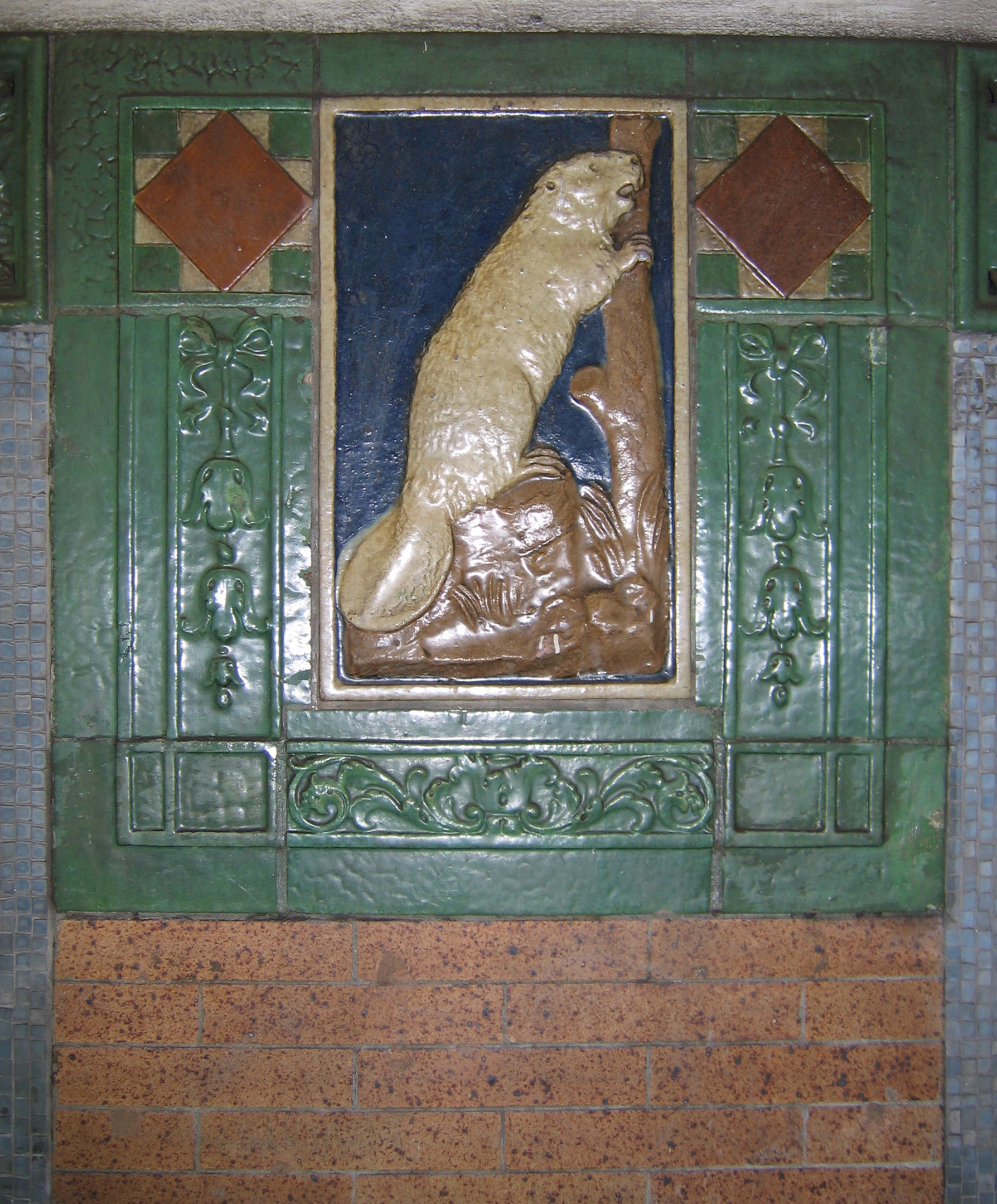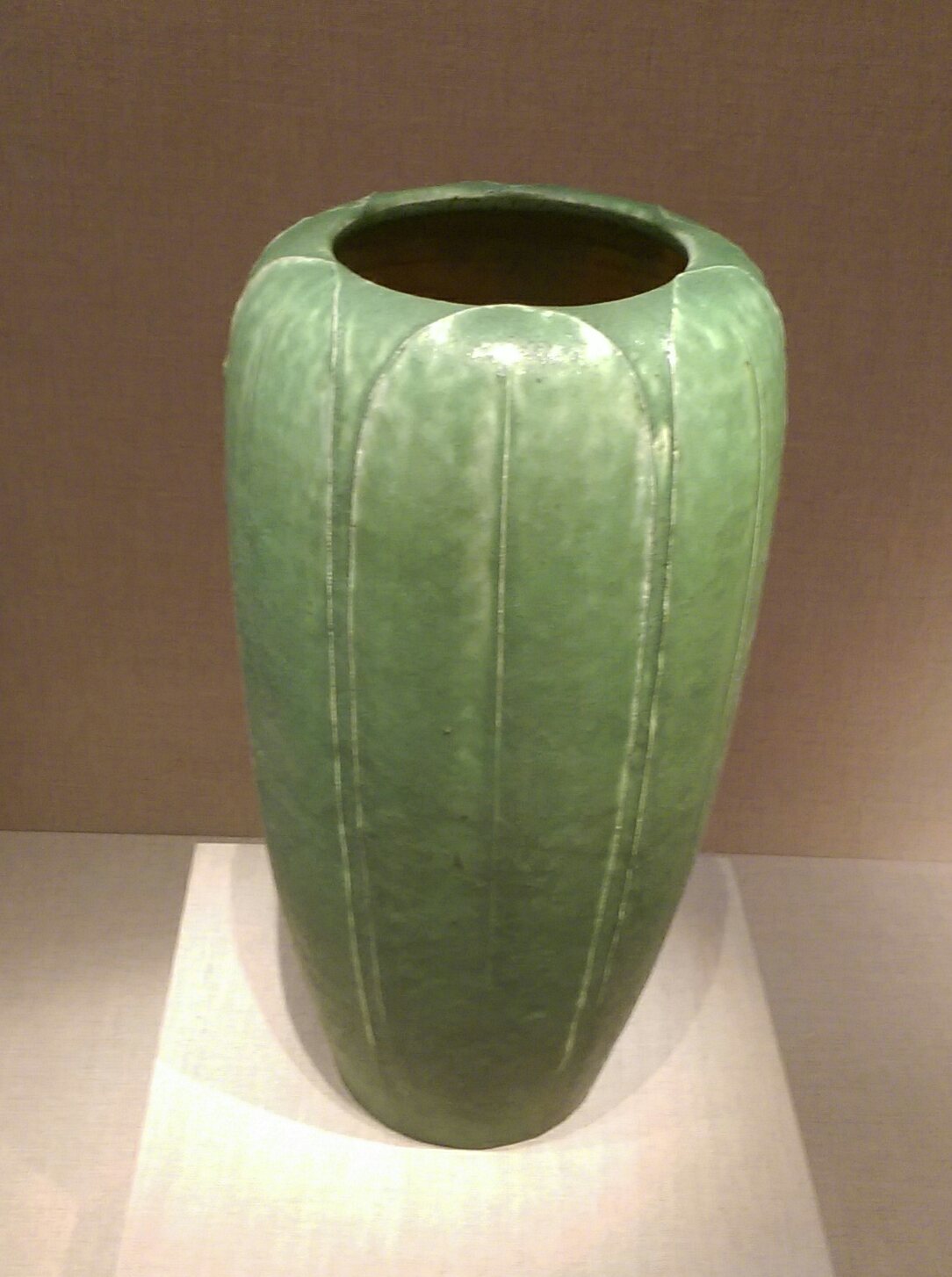Grueby Faience Company on:
[Wikipedia]
[Google]
[Amazon]


 The Grueby Faience Company, founded in 1894, was an American
The Grueby Faience Company, founded in 1894, was an American
Grueby Pottery ExamplesAlice in Wonderland tiles by the Grueby Faience Company
at
Grueby Faience and Pottery
an art dealer's site Arts and Crafts movement American art pottery Art Nouveau


 The Grueby Faience Company, founded in 1894, was an American
The Grueby Faience Company, founded in 1894, was an American ceramic
A ceramic is any of the various hard, brittle, heat-resistant and corrosion-resistant materials made by shaping and then firing an inorganic, nonmetallic material, such as clay, at a high temperature. Common examples are earthenware, porcelain ...
s company that produced distinctive American art pottery
American art pottery (sometimes capitalized) refers to aesthetically distinctive hand-made ceramics in earthenware and stoneware from the period 1870-1950s. Ranging from tall vases to tiles, the work features original designs, simplified shapes, an ...
vases and tiles during America's Arts and Crafts Movement.
The company was founded in Revere, Massachusetts
Revere is a city in Suffolk County, Massachusetts, United States, located approximately from Downtown Crossing, downtown Boston. Founded as North Chelsea in 1846, it was renamed in 1871 after the American Revolutionary War Patriot (American Re ...
, by William Henry Grueby (Boston, 1867—New York, 1925), who had been inspired by the matte glazes on French pottery and the refined simplicity of Japanese ceramics he had seen at the World's Columbian Exposition
The World's Columbian Exposition (also known as the Chicago World's Fair) was a world's fair held in Chicago
(''City in a Garden''); I Will
, image_map =
, map_caption = Interactive Map of Chicago
, coordi ...
in Chicago the previous year; and the architect-designer William Graves. During its first years, the company produced glazed architectural terra cotta and faience
Faience or faïence (; ) is the general English language term for fine tin-glazed pottery. The invention of a white pottery glaze suitable for painted decoration, by the addition of an oxide of tin to the slip of a lead glaze, was a major ad ...
tiles. The company initially focused on simple art pottery
Art pottery is a term for pottery with artistic aspirations, made in relatively small quantities, mostly between about 1870 and 1930. Typically, sets of the usual tableware items are excluded from the term; instead the objects produced are mostly ...
vases designed by George Prentiss Kendrick. Beginning in 1897 and 1898, Grueby introduced matte glazes, including the matte cucumber green that became the company's hallmark.
Grueby's work won two gold medals and one silver medal at the 1900 Exposition Universelle in Paris; medals at the 1901 Pan-American Exposition
The Pan-American Exposition was a World's Fair held in Buffalo, New York, United States, from May 1 through November 2, 1901. The fair occupied of land on the western edge of what is now Delaware Park, extending from Delaware Avenue to Elmwood A ...
in Buffalo, New York
Buffalo is the second-largest city in the U.S. state of New York (behind only New York City) and the seat of Erie County. It is at the eastern end of Lake Erie, at the head of the Niagara River, and is across the Canadian border from South ...
; and a gold medal at both the 1901 St. Petersburg Exhibition of Ceramics and the 1904 Louisiana Purchase Exposition
The Louisiana Purchase Exposition, informally known as the St. Louis World's Fair, was an World's fair, international exposition held in St. Louis, Missouri, United States, from April 30 to December 1, 1904. Local, state, and federal funds tota ...
in St. Louis
St. Louis () is the second-largest city in Missouri, United States. It sits near the confluence of the Mississippi and the Missouri Rivers. In 2020, the city proper had a population of 301,578, while the bi-state metropolitan area, which e ...
.
Grueby Faience stood in the mainstream of Arts and Crafts and Art Nouveau
Art Nouveau (; ) is an international style of art, architecture, and applied art, especially the decorative arts. The style is known by different names in different languages: in German, in Italian, in Catalan, and also known as the Modern ...
design in the United States. Graves and Kendrick were eventually replaced by the architect Addison LeBoutillier and Henry Belknap, who had worked with Louis Comfort Tiffany
Louis Comfort Tiffany (February 18, 1848 – January 17, 1933) was an American artist and designer who worked in the decorative arts and is best known for his work in stained glass. He is the American artist most associated with the Art NouveauL ...
. Later, Karl Langenbeck, formerly of the Rookwood Pottery, would superintend design. Soon Grueby vases were for sale at Samuel Bing
Samuel Siegfried Bing (26 February 1838 – 6 September 1905), who usually gave his name as S. Bing (not to be confused with his brother, Samuel Otto Bing, 1850–1905), was a German-French art dealer who lived in Paris as an adult, and who ...
's shop in Paris, L'Art Nouveau, which gave a name to the progressive art movement, and through Tiffany & Co. in New York, where Tiffany Studios
Tiffany may refer to:
People
* Tiffany (given name), list of people with this name
* Tiffany (surname), list of people with this surname
Known mononymously as "Tiffany":
* Tiffany Darwish, (born 1971), an American singer, songwriter, actress know ...
used Grueby lamp bases. Gustav Stickley
Gustav Stickley (March 9, 1858 – April 15, 1942) was an American furniture manufacturer, design leader, publisher, and a leading voice in the American Arts and Crafts movement. Stickley's design philosophy was a major influence on American ...
incorporated Grueby tiles in his stands and tables, shared a stand with Grueby at the Pan-American Exposition
The Pan-American Exposition was a World's Fair held in Buffalo, New York, United States, from May 1 through November 2, 1901. The fair occupied of land on the western edge of what is now Delaware Park, extending from Delaware Avenue to Elmwood A ...
, and through his catalog offered Grueby vases and lamps.
Grueby's work incited mass-market competition and the company went bankrupt in 1909. Grueby emerged from bankruptcy and began limited production runs that included statues, pottery, and tiles until 1911. There was a fire in the manufactory in 1913, but Grueby rebuilt. In 1917, the C. Pardee Works in Perth Amboy, New Jersey, bought out the company's works; the Grueby company closed for good in 1920.
Grueby Faience Company, which still remains better known for its art pottery
Art pottery is a term for pottery with artistic aspirations, made in relatively small quantities, mostly between about 1870 and 1930. Typically, sets of the usual tableware items are excluded from the term; instead the objects produced are mostly ...
, also produced glazed architectural tiles, which were impressed in molds. Grueby polychrome glazed tiles can still be seen in the revetment
A revetment in stream restoration, river engineering or coastal engineering is a facing of impact-resistant material (such as stone, concrete, sandbags, or wooden piles) applied to a bank or wall in order to absorb the energy of incoming water
...
s of Interborough Rapid Transit Company
The Interborough Rapid Transit Company (IRT) was the private operator of New York City's original underground subway line that opened in 1904, as well as earlier elevated railways and additional rapid transit lines in New York City. The IRT w ...
subway stations in New York and making up the thirty-six original tile murals in the main lobby of Scranton, Pennsylvania's Lackawanna Train Station (restored in 2007-09).
The standard monograph is Susan J. Montgomery, ''The Ceramics of William H. Grueby: The Spirit of New Idea in Artistic Handicraft'', 1993. The collection at Dartmouth College
Dartmouth College (; ) is a private research university in Hanover, New Hampshire. Established in 1769 by Eleazar Wheelock, it is one of the nine colonial colleges chartered before the American Revolution. Although founded to educate Native A ...
is catalogued by Montgomery, ''Grueby Pottery: A New England Arts and Crafts Venture : The William Curry Collection, Hood Museum of Art
The Hood Museum of Art is owned and operated by Dartmouth College, located in Hanover, New Hampshire, in the United States. The first reference to the development of an art collection at Dartmouth dates to 1772, making the collection among the o ...
, Dartmouth College'', 1994.
References
External links
*{{Commons category inline, Grueby Faience CompanyGrueby Pottery Examples
at
Cleveland Public Library
Cleveland Public Library, located in Cleveland, Ohio, operates the Main Library on Superior Avenue in downtown Cleveland, 27 branches throughout the city, a mobile library, a Public Administration Library in City Hall, and the Ohio Library for the ...
Grueby Faience and Pottery
an art dealer's site Arts and Crafts movement American art pottery Art Nouveau